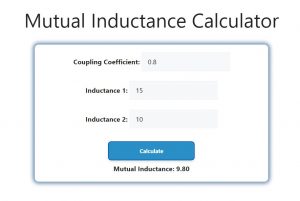About Mutual Inductance Calculator (Formula)
The Mutual Inductance Calculator is an essential tool for electrical engineers and physicists who study electromagnetic fields and circuits. It quantifies how one coil can induce an electromotive force (EMF) in another coil due to the changing current in the first coil. This principle is fundamental in various applications, such as transformers, inductors, and wireless charging systems. By understanding and calculating mutual inductance, professionals can design more efficient electrical systems and components.
Formula
The formula for calculating mutual inductance (I) is:
I = k * sqrt(L1 * L2)
Where:
- I represents the induced current.
- k is the coupling coefficient between the two coils, which ranges from 0 to 1.
- L1 is the self-inductance of the first coil.
- L2 is the self-inductance of the second coil.
How to Use
Using the Mutual Inductance Calculator is straightforward:
- Determine Self-Inductance: Measure or find the self-inductance values (L1 and L2) for both coils.
- Identify the Coupling Coefficient: Determine the coupling coefficient (k), which describes the magnetic coupling between the two coils.
- Input Values: Enter the values of L1, L2, and k into the calculator.
- Calculate: Click the “Calculate” button to find the induced current.
Example
Let’s consider a practical example:
- Self-Inductance of Coil 1 (L1): 10 H (Henries)
- Self-Inductance of Coil 2 (L2): 15 H (Henries)
- Coupling Coefficient (k): 0.8
Using the formula:
I = 0.8 * sqrt(10 * 15)
Calculating further:
I = 0.8 * sqrt(150)
I ≈ 0.8 * 12.247
I ≈ 9.798 A (Amperes)
In this example, the induced current in the second coil would be approximately 9.798 A.

FAQs
1. What is mutual inductance?
Mutual inductance is the phenomenon where a change in current in one coil induces an electromotive force (EMF) in another nearby coil.
2. How is mutual inductance measured?
Mutual inductance is measured in Henries (H), representing the amount of induced voltage per unit of current change.
3. What is the significance of the coupling coefficient (k)?
The coupling coefficient (k) indicates how effectively magnetic field lines link the two coils; a value closer to 1 means strong coupling.
4. How can I determine the self-inductance of a coil?
Self-inductance can be calculated using the formula: L = (N^2 * μ * A) / l, where N is the number of turns, μ is the permeability, A is the cross-sectional area, and l is the length of the coil.
5. Can mutual inductance be negative?
No, mutual inductance is always a positive value, indicating the magnitude of the induced EMF.
6. What happens if the coupling coefficient is zero?
If the coupling coefficient is zero, there will be no mutual inductance, meaning no current will be induced in the second coil.
7. How do distance and orientation affect mutual inductance?
Increasing the distance between coils or changing their orientation can decrease mutual inductance due to weaker magnetic coupling.
8. Are there any practical applications for mutual inductance?
Yes, mutual inductance is crucial in transformers, inductive charging systems, and various types of sensors and motors.
9. How does frequency affect mutual inductance?
Frequency can affect the induced EMF; higher frequencies may enhance energy transfer but can also lead to losses.
10. What is self-inductance?
Self-inductance is the property of a coil to induce voltage in itself due to a change in its own current.
11. How can I increase mutual inductance?
To increase mutual inductance, you can use coils with more turns, reduce the distance between them, or use a magnetic core to enhance coupling.
12. What types of coils are used to measure mutual inductance?
Air-core and iron-core coils are commonly used, depending on the specific application and requirements.
13. Can mutual inductance be used in wireless energy transfer?
Yes, mutual inductance is fundamental in wireless energy transfer systems, allowing for efficient power transmission over short distances.
14. What are the units for measuring mutual inductance?
Mutual inductance is measured in Henries (H), which quantifies the relationship between induced voltage and current change.
15. How do you experimentally measure mutual inductance?
Mutual inductance can be measured by observing the voltage induced in one coil when the current in the other coil is varied.
16. How can I visualize mutual inductance?
Mutual inductance can be visualized by observing magnetic field lines and how they interact between the two coils.
17. Is mutual inductance only applicable in AC circuits?
No, mutual inductance applies to both AC and DC circuits, although it is more pronounced in AC due to alternating currents.
18. What is the formula for total inductance in coupled coils?
The total inductance in coupled coils can be calculated using: L_total = L1 + L2 ± 2M, where M is the mutual inductance.
19. Can mutual inductance be calculated using simulation software?
Yes, various simulation software can model and calculate mutual inductance for complex coil configurations.
20. What are the limitations of using mutual inductance in practical applications?
Limitations include the need for precise alignment, potential losses due to distance, and environmental factors affecting magnetic coupling.
Conclusion
The Mutual Inductance Calculator is an invaluable tool for understanding the interaction between coils in electromagnetic systems. By calculating mutual inductance, engineers and researchers can design more efficient electrical devices and systems. Knowledge of mutual inductance enhances our understanding of electromagnetic principles, facilitating advancements in technology. Whether in academic research or practical applications, the insights gained from mutual inductance are essential for anyone working with electrical circuits and systems.